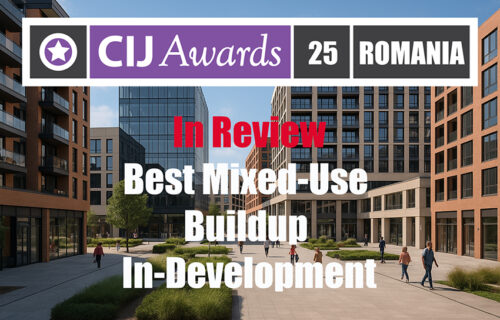Mixed-use development in Romania has reached a point of maturity. For many years, combining housing, retail and offices on a single site was treated as an architectural ambition. Today it is a financial strategy. The projects nominated in this year’s CIJ Awards Romania 2025 “Best Mixed-Use Buildup In-Development” category demonstrate how the concept has evolved into an institutional asset class capable of attracting international tenants, financing from major lenders and long-term investors looking for stable income.
Across the shortlist, one theme is consistent: the strongest projects are no longer designed around the square metres they can build, but around the economy of daily use. They pair revenue from housing with recurring income from offices and retail, while public space, community amenities and connectivity sustain footfall without relying on destination marketing. Their value is created not by selling or leasing space, but by shaping places to which people return every day.
AFI Park Brașov represents this model clearly. Anchored to an already successful shopping centre, the development layers modern office functions above an established retail platform. Because the first phase is fully operational and the site is zoned, future construction becomes an expansion rather than speculation. Brașov attracts both tourists and regional commuters, and that constant movement of people supports the project’s retail performance while strengthening the office leasing story. The result is predictable income and a low-risk profile for lenders.
In Bucharest, Amber Forest shows how suburban development can become economically resilient when the lifestyle component is embedded from the beginning. The homes, school, wellness facilities and local commerce are designed as a single ecosystem rather than independent parcels of land. Most housing units are already sold, which reduces the financing burden and protects the commercial stage from market volatility. Demand is driven not only by proximity to Bucharest’s wealthiest residential corridor, but also by access to a natural green belt — a feature that increasingly commands a pricing premium.
Brașov’s Coresi district demonstrates what happens when mixed-use succeeds at district scale. Built on a former industrial platform, the area has become a fully functioning urban quarter. The variety of uses, from residential to retail and offices, generates continuous activity through morning, daytime and evening. Because tenants and residents overlap and feed into each other’s presence, vacancy exposure is significantly reduced. Coresi illustrates how placemaking results in financial defensibility: demand is anchored not to a building, but to a neighbourhood.
In Timișoara, Paltim takes a boutique and heritage-focused approach. Its appeal lies not in volume, but in scarcity. Restoring historic structures and integrating them into a modern residential and retail layout is capital intensive, yet once completed the asset is difficult to replicate. The emotional value of heritage and the scarcity of similar opportunities in prime locations give the project long-term pricing power and protect it from competing supply.
Promenada in Bucharest continues the evolution of an urban retail centre into an integrated commercial hub. Significant new investment and strong pre-leasing before construction completion signal market confidence. Major retailers are increasing their footprint in the project, a clear indication that the location retains strategic relevance for brands targeting Bucharest’s most affluent catchment.
Cluj-Napoca’s RIVUS, led by Iulius and Atterbury, is the largest of the nominations and has the most transformative effect on its host city. It turns a former industrial site into a major commercial district. Cluj’s above-average purchasing power and young workforce support the project’s retail and office demand, while public infrastructure upgrades around the development demonstrate alignment with the city’s long-term mobility strategy. In investment terms, the scheme has the potential to become a self-sustaining commercial destination.
In Bucharest’s Obor district, the SkyLight project follows the momentum of an area undergoing rapid regeneration. Demand in the neighbourhood already exists due to a major transport interchange and established retail centres, meaning the project enters a rising market rather than creating one from scratch. The long-term success of the commercial element depends on residential absorption, yet the location’s demographic shift provides a solid foundation.
Another Bucharest project, Timpuri Noi Square 2, shows how sustainability is now part of financial modelling. Designed to operate with low carbon emissions and future EU regulatory requirements in mind, it positions itself as a long-term tenancy choice for corporations that must comply with ESG standards. Energy-efficient operations reduce occupancy costs and strengthen leasing prospects.
U•Center 3 by Forte Partners reflects the value of historical performance. The previous stages of the same development reached full occupancy before delivery, which gives the final phase credibility. Proximity to one of Bucharest’s main parks and strong public transport access further increase its appeal for employers competing for talent.
Across all nominations, a new economic logic is visible. The projects with the strongest financial resilience are those that create permanence of use. They generate continuous reasons for people to interact with the space — to work, to live, to study, to shop, to exercise. They diversify revenue streams across several asset classes and reduce exposure to market cycles. They secure land early and resolve zoning issues before construction begins, which protects lenders from regulatory risk. And they position community infrastructure — schools, parks, leisure or wellness facilities — not as decorative amenities but as stabilisers of long-term income.
Mixed-use, in this market, is no longer a matter of combining functions. It is a matter of creating value through integration. The most successful projects in this year’s nominations do not attract people. They retain them. And in real estate, retention is more powerful — and more bankable — than attraction.
Source: CIJ EUROPE Analysis Team © 2025 cij.world
